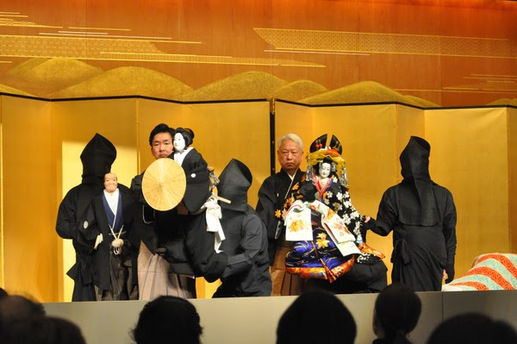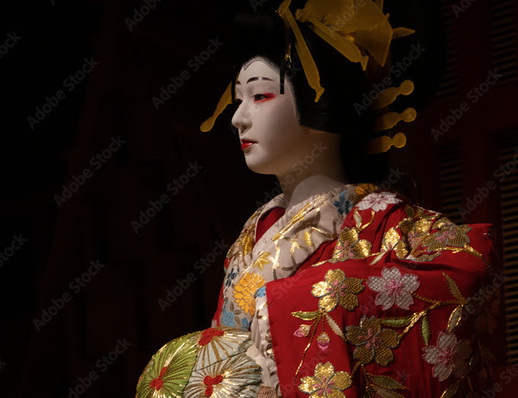2024.11.21
伝検通信(メルマガ)週刊メールマガジン「伝検通信」 第33号
週刊メールマガジン「伝検通信」第33号をお届けします。
今週のトップ記事は、西武ホールディングスが取り組んでいる伝統文化支援の話題です。
「クイズで肩慣らし」は前回クイズの答え・解説と、陶磁器・ガラス分野からの出題です。
今月29日から実施する2級および3級の第1回伝検の受験申し込みを受け付けています。公式テキスト、2級受験者向けオンライン講座の販売もスタートしています。ぜひお申し込みください。
伝検申込サイト https://denken-test.jp/
目次
・ 伝統文化で「五感揺さぶる体験を」 =西武HD、日本の魅力発信
・ 「クイズで肩慣らし」第33回(陶磁器・ガラス)=「外壁材としての陶磁器」
・ 伝検協会だより
伝統文化で「五感揺さぶる体験を」 =西武HD、日本の魅力発信

静岡県・伊豆長岡温泉の旅館で行われた人形浄瑠璃文楽の公演
(西武ホールディングス提供)
西武ホールディングス(HD)が伝統文化関連事業に力を入れている。同社保有の歴史ある宿泊施設などを活用し、伝統芸能や工芸品といった日本の魅力を発信。スポーツ・アーツ&カルチャー事業戦略部の國貞幸枝部長は「日本の伝統文化を通じて五感を揺さぶるような体験を提供していきたい」と力を込める。
◇インバウンド、若手中心に新たな動き
経済産業省によると、2020年時点の伝統的工芸品の従業員数(約5万4000人)と生産額(約870億円)は、それぞれ1980年ごろと比べて8割以上減少。國貞氏は「担い手の減少や生活様式の変化などにより、(日本の伝統文化は)厳しい状況にあるが、海外のお客さまが興味を持ったり、若手工芸家が販路を海外に求めたりするなど、新しい動きもある」と指摘する。
こうした現状も踏まえ、西武HDは今年5月に公表した「西武グループ長期戦略2035」で、成長に向けて取り組むべき重要テーマの一つに「五感を揺さぶる体験創造」を掲げ、伝統文化などを主要コンテンツに位置付けた。その事業の一翼を担うのが、スポーツ、芸術、文化を軸にグループ横断的な施策を進める22年新設のスポーツ・アーツ&カルチャー事業戦略部だ。
西武HDは具体的な取り組みとして、読売新聞グループ本社による伝統文化を次世代に継承する支援プロジェクト「Action!伝統文化」に参加。第1弾として、23年7月に人間国宝の室瀬和美氏(蒔絵=まきえ=)、十四代今泉今右衛門氏(色絵磁器)による、工芸と食のイベントを料亭「有栖川清水」(東京都港区)で実施した。
◇顧客基盤と伝統文化つなぎ、新しい価値創造
今年2月には静岡県・伊豆長岡温泉の旅館「三養荘」で、江戸時代から続く伝統芸能「人形浄瑠璃文楽」の公演を開催し、人形遣いの吉田勘彌氏の演出で、宿泊客向けに「ひらかな盛衰記 神崎揚屋(かんざきあげや)の段」を上演。國貞氏は「人間国宝の伝統工芸作品が飾られた舞台でもあり、大好評だった」と手応えを感じており、来年2月にも三養荘で文楽を堪能できるイベントを実施する。
10月には東京都内の「ザ・プリンスギャラリー東京紀尾井町」で、米人気歌手のレディー・ガガさんが愛用した「ヒールレスシューズ」を手掛けた現代アーティストの舘鼻則孝さんらのトークショーを開催。海外でも活躍する舘鼻さんは「日本の工芸文化とその進化した形を世界に発信していきたい」と強調した。
西武HDは今後、全国各地の伝統芸能・工芸品などをテーマに、地域貢献やにぎわい創出に取り組む。國貞氏は「西武の顧客基盤と伝統文化をつなぎ、西武ならではの体験を生み出すことが、グループの価値を高めるとともに、伝統文化の振興に向けて新しい価値をつくり出すことになる」と力強く語った。
「クイズで肩慣らし」第33回(陶磁器・ガラス)=「外壁材としての陶磁器」
~伝検公式テキスト(好評発売中)の分野ごとに出題します~

1936年11月に建設された国会議事堂(東京都千代田区)
第32回
問題:日本の国会が開かれる「国会議事堂」。建物の象徴となっている中央塔の屋根の部分に当たるピラミッド型の塔屋に、タイルとして使用されている陶磁器は何でしょうか。(答えと解説は次号で)

絢爛豪華な歌舞伎衣装
【前回の問題と答え・解説】
問題:歌舞伎の女方が身にまとう華やかな衣装は、 歌舞伎観劇の楽しみの一つです。歌舞伎演目「助六由縁江戸桜(すけろくゆかりのえどざくら)」に登場する花魁(おいらん)「揚巻(あげまき)」が着用する衣装に見られる、 前で結んだ大きな帯の名前は何でしょうか。
答え:まな板帯
解説:花魁の正装用の帯は「まな板帯」と呼ばれます。帯は通常、後ろで結ばれますが、このまな板帯は胸の前で結ぶのが特徴で、胸元に大きなまな板をぶら下げているように見えることから、この名前が付けられました。歌舞伎演目「助六由縁江戸桜」に登場する花魁「揚巻」や、「籠釣瓶花街酔醒(かごつるべさとのえいざめ)」の「八ツ橋」などが身につけています。
伝検協会だより
▼新潟県佐渡市の焼物「佐渡無名異焼(さどむみょういやき)」
▼伝検第1回検定が11月29日に始まりますが、1週間前のあす22日、伝検通信臨時増刊号を配信、検定直前の学習ポイントを紹介します。例題もありますので、ご一読ください。
編集後記
伝検通信33号をお届けしました。いよいよ来週末から第1回伝検2級・3級試験が始まります。ぜひ公式テキストや伝検サイトの情報を活用してご準備をお進めください。
【English version】
Weekly e-mail magazine “DENKEN TSUSHIN” No.33
We are pleased to present the 33rd issue of our weekly e-mail newsletter, DENKEN TSUSHIN.
This week's top article is about Seibu Holdings' efforts to support traditional culture.
In the “Quiz to Get Used to Yourself” section, you will find answers and explanations to the previous quiz, as well as questions from the ceramic and glass fields.
We are now accepting applications for the first DENKEN test for Level 2 and Level 3, which will be held on the 29th of this month. The official textbooks and online courses for Level 2 examinees are also on sale. Please register now.
Denken application website: https://denken-test.jp/examination/
Table of Contents
・Seibu HD, a Japanese company that promotes the appeal of traditional Japanese culture, offers visitors an experience that will thrill all five senses.
・Let's Practice with Quizzes No. 33 (Ceramics and Glass) = “Ceramics as Exterior Wall Materials
・From the Denken Kyokai
Seibu HD to promote the charms of Japan through traditional culture, “an experience that will jolt the five senses

Ningyo Joruri Bunraku performance at a ryokan in Izu Nagaoka Onsen, Shizuoka Prefecture.
(Courtesy of Seibu Holdings Co.)
Seibu Holdings (HD) is focusing on traditional culture-related business. The company is using its historic lodging facilities to promote the appeal of Japanese traditional arts and crafts. Ms. Yukie Kunisada, manager of the Sports, Arts & Culture Business Strategy Department, says, “We would like to provide experiences that will shake the five senses through traditional Japanese culture.
◇Inbound tourism: New movement centered on young people
According to the Ministry of Economy, Trade and Industry, the number of employees (approximately 54,000) and the production value (approximately 87 billion yen) of traditional crafts in 2020 will have decreased by more than 80% from around 1980. Kunisada pointed out that “Japanese traditional culture is in a difficult situation due to a decrease in the number of bearers and changes in lifestyles, but there are also new trends, such as overseas customers taking an interest and young craftspeople seeking overseas sales channels.
In light of this situation, Seibu HD has identified “creation of experiences that thrill the senses” as one of the key themes for growth in its “Seibu Group Long-Term Strategy 2035,” released in May of this year, and has positioned traditional culture as a major source of content. The Sports, Arts & Culture Business Strategy Department, newly established in 2010, will play a role in this business by promoting group-wide measures centered on sports, arts, and culture.
As a specific initiative, Seibu HD is participating in the Yomiuri Shimbun Group's “Action! Traditional Culture” project to support the transmission of traditional culture to the next generation. As a first step, in July 2011, Seibu HD held an event featuring crafts and food by Living National Treasures Kazumi Murose (makie) and Imaizumi Imaemon XIV (iroe porcelain) at the ryotei Arisugawa Kiyomizu (Minato-ku, Tokyo).
◇Creating New Value by Connecting Customer Base and Traditional Culture
In February this year, “Sanyoso,” a ryokan located in Izu Nagaoka Onsen, Shizuoka Prefecture, hosted a performance of Bunraku puppet theater, a traditional art form that has continued since the Edo period. Kunisada feels that the performance was very well received, as the stage was decorated with traditional craft works by living national treasures,” and he plans to hold another event at Sanyoso next February to allow guests to enjoy Bunraku.
In October, the Prince Gallery Tokyo Kioicho in Tokyo will host a talk show featuring Noritaka Tatehana, a contemporary artist who created the “heel-less shoes” used by the popular American singer Lady Gaga. Mr. Tatehana, who is also active overseas, emphasized that he would like to promote Japanese craft culture and its evolved forms to the world.
Seibu HD will continue its efforts to contribute to local communities and create liveliness through themes such as traditional arts and crafts in various regions of Japan. Mr. Kunisada stated emphatically, “Connecting Seibu's customer base with traditional culture and creating experiences unique to Seibu will enhance the value of the group and create new value for the promotion of traditional culture.
Let's Practice with Quizzes No. 33 (Ceramics and Glass) = “Ceramics as Exterior Wall Materials”
~Questions will be given for each field in the official DENKEN textbook (now on sale).

The National Diet Building, built in November 1936, Chiyoda-ku, Tokyo
Question: The National Diet Building is where the Japanese Diet is held. What kind of ceramic is used as tiles for the pyramid-shaped roof of the central tower, which is the symbol of the building? (Answers and explanations will appear in the next issue.)

Gorgeous Kabuki costumes
Previous Question and Answer / Explanation
Question: The gorgeous costumes worn by the female actors in Kabuki are one of the pleasures of Kabuki theater. What is the name of the large sash tied in front worn by the oiran (courtesan) “Agemaki” in the Kabuki play “Sukeroku Yukari no Edozakura”?
Answer: chopping board belt
Explanation: The formal kimono sash worn by oiran is called a manaita obi. The obi is usually tied at the back, but this manaita obi is characterized by being tied in front of the chest, giving it the appearance of a large cutting board hanging from the chest, hence the name. It is worn by “Agemaki,” a courtesan in the Kabuki play “Sukeroku Yuren Edo Sakura” and “Yatsuhashi” in “Kagotsurube Hanamachi Eizame.
From Denken Kyokai
Sado Mumyoi ware from Sado City, Niigata Prefecture, and Izumi glass from Izumi City, Osaka Prefecture, were designated as national traditional crafts on October 17. This brings the total number of traditional crafts to 243. For details, please visit the Ministry of Economy, Trade and Industry website (“Sado Mumyoi Ware” and “Izumi Glass” were designated as traditional crafts [METI/Ministry of Economy, Trade and Industry]). Please note that the “List of Designated Traditional Crafts” at the end of the official DENKEN textbook is as of July 31, 2024, and does not include the two new items.
The first DENKEN certification test will be held on November 29, and we will send out an extra issue of DENKEN News on tomorrow, November 22, one week before the test. Please read it carefully as there are some example questions.
editorial postscript
We are pleased to present DENKEN News Letter No. 33. Finally, the first DENKEN Level 2 and Level 3 examinations will begin next weekend. Please make use of the official textbooks and information on the DENKEN website to prepare for the examinations.
カテゴリー: 伝検通信(メルマガ)





